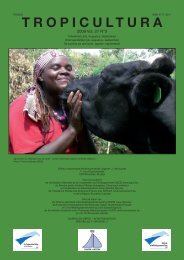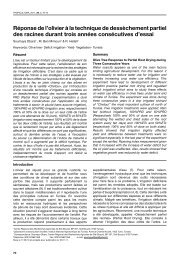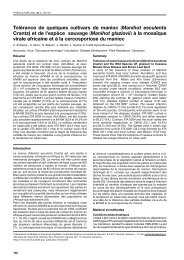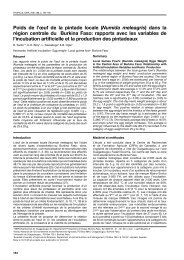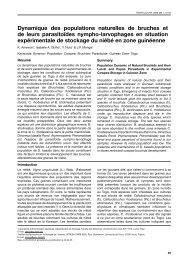Fascicule entier - Tropicultura
Fascicule entier - Tropicultura
Fascicule entier - Tropicultura
Create successful ePaper yourself
Turn your PDF publications into a flip-book with our unique Google optimized e-Paper software.
ORGANISATION<br />
Concept of editors and objectives of TROPICULTURA<br />
Agri-Overseas is an association created in order to establish common-interest professional relationships between people working on overseas<br />
rural development. It publishes the scientific and information publication «<strong>Tropicultura</strong>» which covers rural problems in developing countries. This<br />
publication is published every three months with the financial support of the «Directorate- General for Development Cooperation (D.G.D.C.), Federal<br />
Public Service Foreign Affairs, Foreign Trade and Development Cooperation Belgium». It benefits from the scientific patronage of the Belgian Royal<br />
Academy for Overseas Sciences (RAOS) and the «Région Bruxelles-Capitale».<br />
Agri-Overseas is composed of both individual members and members of the following Belgian Institutions: the Belgian Royal Academy for Overseas<br />
Sciences (RAOS), the «Commission universitaire pour le développement» of the «Conseil interuniversitaire de la Communauté française» (CUD-CIUF),<br />
the authority of «Universitaire/Ontwikkelingssamenwerking» of the «Vlaamse Interuniversitaire Raad» (VLIR-UOS), the four Faculties of Agronomy<br />
(Gembloux, Ghent, Leuven and Louvain-la-Neuve), the two Faculties of Veterinary Medecine (Ghent and Liège), the Department Animal Health of<br />
the Institute of Tropical Medecine in Antwerp, the Inter-faculty Section of Agronomy of the Université Libre de Bruxelles (Brussels), the Facultés<br />
Universitaires Notre Dame de la Paix (Namur), the Department of Environment Sciences and Management from the University of Liège and the<br />
Directorate General for Development Cooperation.<br />
Board<br />
The Board of Agri-Overseas is as follows: Professor Dr J. Vercruysse, President; Professor Dr Ir G. Mergeai, Administrator; Dr E. Thys, Secretary;<br />
Professor Dr B. Losson, Treasurer; Dr S. Geerts, member and Honorary Professor Dr Ir J. Hardouin, member.<br />
Editorial Staff<br />
The Publication Committee of TROPICULTURA is made up of Professor Dr Ir G. Mergeai, Chief editor, and the following editorial staff: Professor<br />
Dr J.-P. Dehoux for “Animal Production and Animal Life Control”, Dr D. de Lame for “Sociology”, Honorary Professor Dr Ir F. Malaisse for “Forestry<br />
and Ecology, Professor Emeritus Dr J.-C. Micha for “Fishing and Pisciculture”, Professor Dr Ir E. Tollens for “Rural Economy”, Professor Dr Ir P. Van<br />
Damme for “Agronomy and Forestry”, Professor Dr E. Van Ranst for “Soil Science”, Professor Dr J. Vercruysse and Dr E. Thys for “Animal Health”<br />
and Ir. F. Maes, scientific associate. The secretariat deals directly with the other topics relevant to the revue (economy, sociology, etc …).<br />
Publication secretariat<br />
11, rue d’Egmont B- 1000 Brussels – Belgium<br />
Telephone: ++32.2.540 88 60/ 61; Fax.: ++32.2.540 88 59<br />
Email: ghare.tropicultura@belgacom.net/ mjdesmet.tropicultura@belgacom.net<br />
Website: http://www.bib.fsagx.ac.be/tropicultura/<br />
Distribution<br />
The distribution of TROPICULTURA is free and may be obtained on request by writing to the publication Secretariat.<br />
SCOPE OF THE PUBLICATION<br />
TROPICULTURA publishes original articles, research and synthesis notes, book and thesis summaries as well as reviews of films and videos relative<br />
to all aspects of rural development: plant and animal production, veterinary science, forestry science, soil science, rural engineering, environmental<br />
sciences, bio-industry, agro-food science, sociology and economy.<br />
INSTRUCTIONS TO AUTHORS<br />
The themes of articles published in <strong>Tropicultura</strong> concern all that is relative to rural development and sustainable management of the environment in<br />
warm regions of the planet. Priority is given to articles with original subjects, with as wide a scope as possible, i.e. for which the content concerns<br />
especially methodological aspects which can be transposed in a wide range of environments and regions of the world. A particular accent is put<br />
on the reliability of the information published, which means, for experimental results, on the number of trial repetitions, in time and in space, at the<br />
origin of the data obtained.<br />
Manuscripts must be original reports that have not been previously published , or simultaneously submitted elsewhere. They may be drafted in one<br />
of the following languages: English, Spanish, French or Dutch. Manuscripts should be sent in triplicate to the chief of the editorial board, either by<br />
post in paper form or directly, by electronic mail to the publication Secretariat, in the form of electronic files. Manuscripts should be typed with double<br />
spacing on one side of the paper (27 lines of 60 characters per DIN A4 page), with a margin of 3.5-cm minimum around the printed page. Texts should<br />
be no longer than ten pages (cover page, abstracts and references not included).<br />
The cover page should include the title, the abridged title (55 characters maximum), the complete names and forenames of the authors, the complete<br />
professional address of each one, and any acknowledgements. The name of the corresponding author- to whom all correspondence should be sent<br />
should be marked with an “*” and the address should contain telephone and fax numbers as well as the electronic address. The following pages<br />
should provide: (i) an abstract (200 words maximum) in the manuscript’s language and in English, preceded by the translated title and followed by a<br />
maximum six keywords in both languages; (ii) the main text; (iii) the references; (iv) only three tables numbered in Arabic numerals will be accepted; (v)<br />
illustrations clearly identified with a number on the back; (vi) captions of the illustrations and tables. All the pages should be continuously numbered.<br />
Only three figures will be accepted. They should be drawn in a professional manner. Photographs should be non-mounted, well contrasted on shiny<br />
paper.<br />
Only the co-authors which have given a written agreement that their name may be published in a manuscript will appear in the final version of the<br />
article published in <strong>Tropicultura</strong>. The written agreements of the co-authors for this matter can be transmitted to the editorial committee by post or<br />
by e-mail. The agreement of the author’s responsible organism is supposed accepted for all publication in <strong>Tropicultura</strong>. Agri-Oversesa declines all<br />
responsibility in thgis matter.<br />
The original submission may be in paper or electronic form. If possible, after acceptance, submission of the final revision is strongly encouraged on<br />
diskette or as an attached file. Word is the preferred software, but ASCII and RTF versions of the files are acceptable.<br />
The text normally should be divided into Introduction, Material and methods, Results, Discussion and Conclusion. Text subdivision should not<br />
exceed two levels. Sub-titles, very concise, should be written in lower case letters and never underlined.<br />
All references should be cited in the text with numbers in parentheses. For more than two references, numbers should follow in ascending order.<br />
References will be given in alphabetical order of author’s name and in chronological order for a given author. They will be continuously numbered<br />
beginning with the number 1.<br />
For journal publications, references will include author names preceded by forename initials, year of publication, complete title of the publication in<br />
the original language, name of the Journal, underlined volume number, number of the first and last page separated by a hyphen.<br />
Example: Poste G., 1972, Mechanisms of virus induced cell fusion. Int. Rev. Cytol. 33, 157-222.<br />
For monographs, the following elements are essential: author name followed by forename initials, year of publication, complete title of the publication,<br />
editor name, place of edition, first and last page of mentioned chapter, total number of pages in the publication. Conference proceedings are to have<br />
the same format as monographs; plus , they should mention if possible the place and date of the conference and the scientific editor(s).<br />
Example: Korbach M.M. & Ziger R.S., 1972, Heterozygotes detection in Tay-Sachs disease a prototype community screening program for the<br />
prevention of recessive genetic disorders pp 613-632, in: B.W. Volks & S.M. Aronson (Editors), Sphingolipids and allied disorders, Plenum, New-York,<br />
205 p.<br />
The Publication Committee is entitled to refuse any article which does not comply with the prescriptions above.<br />
The articles are submitted to one or more referees chosen by the Editor and these referees will remain anonymous to the authors.<br />
Once accepted for publication, the publication committee requires the different authors to transfer their publication rights to TROPICULTURA.<br />
Texte français dans le n°1 Nederlandse tekst in Nr.3 Texto Español en el N°4



